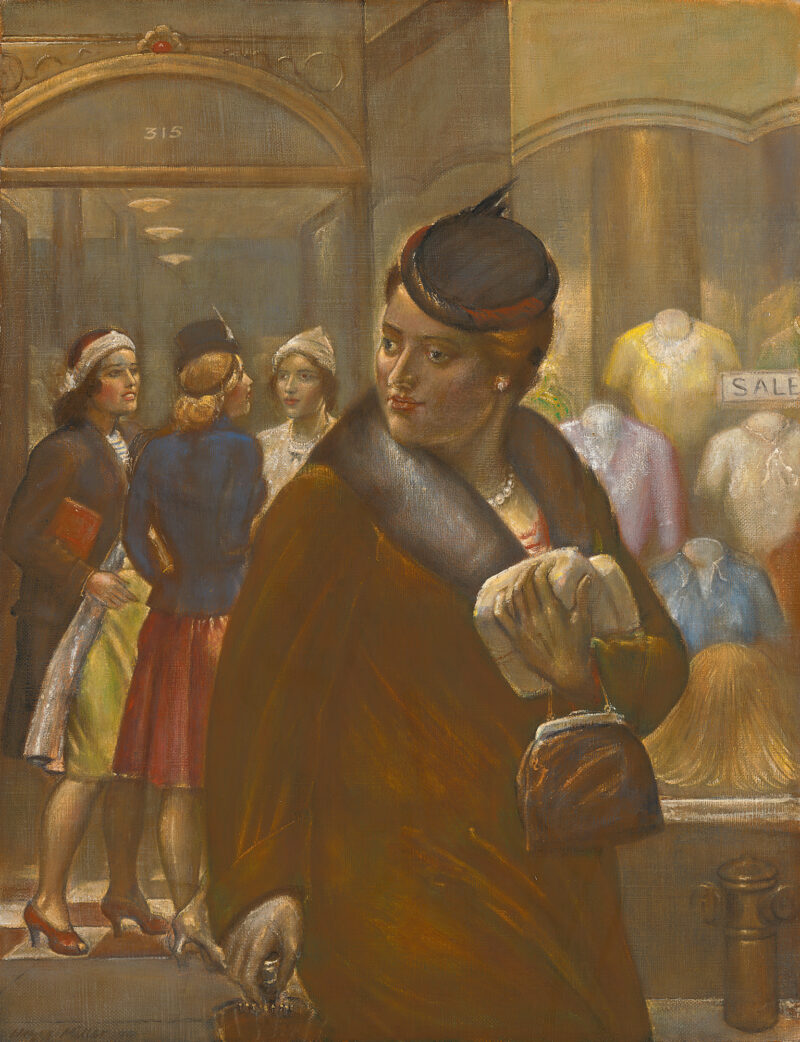
Show Window #2
Miller, Kenneth Hayes
1940
Artwork Information
-
Title:
Show Window #2
-
Artist:
Miller, Kenneth Hayes
-
Artist Bio:
American, 1876–1952
-
Date:
1940
-
Medium:
Oil on canvas
-
Dimensions:
27 1/2 x 21 1/8 inches
-
Credit Line:
Wichita Art Museum, Museum purchase, Friends of the Wichita Art Museum
-
Object Number:
1980.67
-
Display:
Currently on Display
About the Artwork
Kenneth Hayes Miller painted Show Window #2 at the height of his reputation as an important artist and teacher. Born in Oneida, New York, Miller first studied and then taught at both the Art Students League and the New York School of Art. Over the course of four decades Miller influenced generations of American artists; his most prominent students included George Bellows, Edward Hopper, Yasuo Kuniyoshi, Edward Laning, Reginald Marsh and Isabel Bishop.
Miller’s figurative style and distinctly American subject matter appealed to art critics and patrons, many of whom shared the artist s disapproval of European modernism. Miller began painting the New York urban scene in the 1920s, observing from his studio along Fourteenth Street the bustling daily activities of the Union Square district. He focused, in particular on women searching for bargains in this lower- to middle-class commercial area known for its numerous retail stores.
Miller did not profess in his paintings to offer commentary on the socio-economic conditions of Union Square, but instead claimed to be primarily concerned with formal issues. Miller’s clean, carefully composed street scenes and volumetric figures recall classical precedents; in fact, the American artist self-consciously adopted the conventions of Old Masters such as Raphael, Titian, Rubens and Rembrandt. Miller differentiated shapes through his controlled brushwork and use of dark outlines, which were in turn reinforced by a repetition of rounded inner contours.
Although Miller’s own statements about his work emphasized a preoccupation with structure and sculptural form, his images of women shopping can be understood in the context of a burgeoning female-oriented consumer culture. The matronly shopper in the foreground of Show Window #2, already clutching a number of packages to her bosom, eagerly looks over her right shoulder as if yet another item has caught her attention. Behind her converse three younger women, who in number and pose recall the mythic Three Graces, a motif that Miller frequently employed. Their youthful female forms counterbalance a window display of buxom torsos. Miller’s selective use of bright, high-keyed color draws attention to the sale blouses in the vitrine, as well as to the young women’s clothing and their heavily made-up faces. Like the mass-produced items they wear, these models of feminine beauty are at once signs of modernity, urbanism and sexuality. By conjoining both traditional and modern images of women, Miller creates a reassuring image for the Depression era. By partaking in a domestic leisure activity, these women, in the words of one recent scholar, “implied that financial stability would re-emerge, consumption would continue, and society would prosper.”1
1. Ellen Wiley Todd, The “New Woman” Revised: Painting and Gender Politics on Fourteenth Street (Berkeley: University of California Press, 1993), 167.